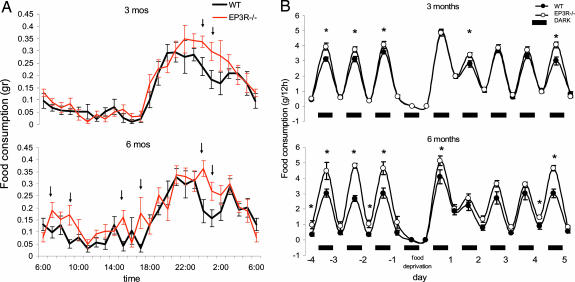Fig. 5.
EP3R−/− mice showed increased food consumption. (A and B) Hourly food-intake events as a function of time (A) and effects of 24 h of fasting in EP3R−/− and WT littermates (B). In A, at 3 months of age (Upper), EP3R−/− mice show an increase in food intake characterized by continuous feeding during the dark period (see arrows), whereas WT littermate controls show a similar increase in feeding followed by a period of temporary decrease and then by a second increase in food consumption in the same period. At 6 months of age (Lower), the increase in feeding in the EP3R−/− mice is extended to the light cycle (see arrows; P values are given in the text). In B, food intake was measured every 12 h. At 3 months of age (Upper), baseline measurement for 3 days confirmed that EP3R−/− mice ate more during the dark period (∗, P < 0.05). At 6 months of age (Lower), cumulative data indicate that EP3R−/− mice ate more during both light and dark cycles (∗, P < 0.05). At both ages, food deprivation increases food intake in the next dark and light period in both strains and returns to the baseline pattern after day 4.

